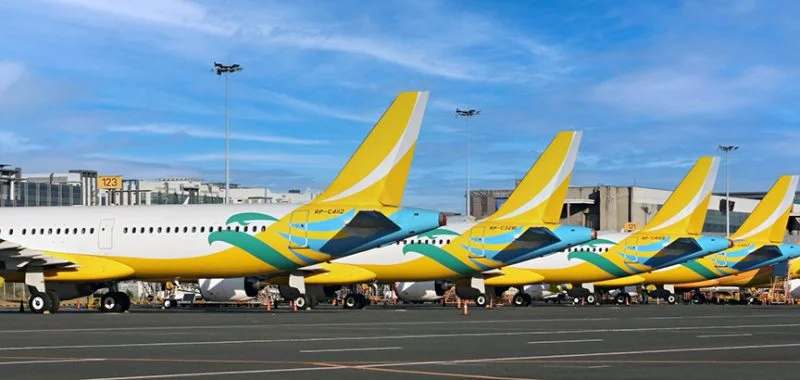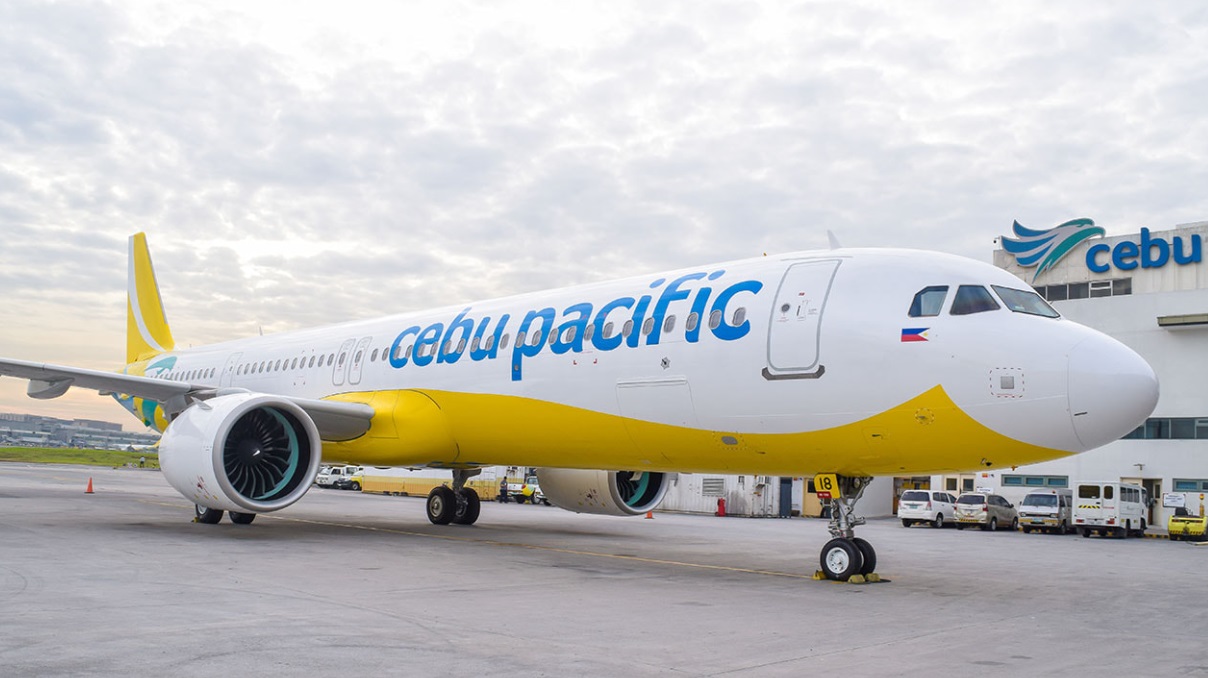Search Results forcebu pacific
Cebu Pacific flew 13.9 million passengers in first half of 2025
Philippine low-cost carrier Cebu Pacific continues to record growth, flying 13.9 million passengers for the first half of 2025. The mid-year total is up 20.8 percent from the 11.5 million reported in the first half of 2024. In a statement released on Tuesday, 15th July, airline president Xander Lao said: "For the first half of 2025, our load factors have increased despite seat growth of more than 20 percent. This reflects the continued strength of air travel demand within our network.” Lao added that the low-cost carrier's capacity for the second half of June was reduced due to the onset of the leaner season. He said: "This also aligns with ongoing proactive management of engine and supply chain issues and as such we would expect capacity growth levels to stay at similar levels through the third quarter before rising again in the fourth quarter.” Key statistics from H1-2025 For the first half of 2025, Cebu Pacific’s seat load factor averaged 85.4 percent. Last month, the airline flew 2.2 million passengers, 7.9 percent more than the passengers it carried in June 2024. However, despite the growth, Cebu Pacific’s seat load factor in June decreased slightly to 87.5 percent year-over-year from the 88.3 percent reported in the same period last year. Domestic passenger traffic in June grew by 7.3 percent, while international passenger traffic was up by 9.7 percent higher.
Cebu Pacific does its part in the restoration of Cebu’s mangrove forests
Philippine low-cost carrier Cebu Pacific formally turned over at least 10,000 mangroves to the Tapon Fisherfolk Association and the local government of Dumanjug in Cebu province on Friday, 12th July. In a statement released concurrently with the turnover, airline vice-president for corporate strategy and risk officer Aileen Isidro said: “We are proud to stand alongside RAFI and the Tapon Fisherfolk Association as we work to restore and protect our coastlines. These efforts help preserve biodiversity, strengthen community resilience, and secure livelihood for future generations.” Turning over the site to the Association is the airline’s way of supporting the fisherfolk's livelihood whilst enhancing coastal protection. What came before The airline has been maintaining the mangrove conservation site since 2023 as part of its ongoing sustainability measures. The original tree planting project on the site was a joint effort of Cebu Pacific employees, the local government, Association members, as well as the Ramon Aboitiz Foundation Inc (RAFI). The site was previously under the care of RAFI, but the airline came in via a three-year partnership to take care of the mangrove site and offer livelihood support to the local fisherfolk. To date, more than five hectares of coastline have been restored, and 35 members of the Tapon Fisherfolks Association have received training in seedling propagation, site preparation, and mangrove planting. The association will now take the lead in maintaining and monitoring the mangrove sites.
Cebu Pacific renews IATA Operational Safety Audit Registry entry
Philippine low-cost carrier Cebu Pacific announced that it successfully renewed its IATA Operational Safety Audit (IOSA) registry. This renewal reaffirms the airline’s long-standing commitment to safety in light of its ongoing expansion and rapid growth. This marks the airline’s first renewal under the more stringent Risk-Based IOSA, a data-driven approach introduced by the International Air Transport Association (IATA) to enhance the assessment of airline safety. Cebu Pacific initially earned its IOSA registration in 2018 and has consistently passed the biennial audit since. According to airline chief operations officer Javier Massot: “The IOSA renewal reflects the strength of our internal safety processes and the culture of excellence we uphold in our operations. Safety has always been at the core of what we do, and we are proud to meet global benchmarks as we continue to expand our network.” Sterling credentials In addition, Cebu Pacific has also merited global recognition for its overall safety performance. Earlier this month, AirlineRatings.com named the airline one of the world’s Safest Low-Cost Carriers (LCCs), citing its strong safety record, low incident rate, and investment in a modern fleet. As part of its ongoing fleet modernisation, the airline signed a purchase agreement with Airbus for up to 152 A320neo aircraft last year, the largest in Philippine aviation history. The purchase further supports Cebu Pacific’s transition to an all-NEO fleet focused on fuel efficiency and sustainability.
Cebu Pacific honours overseas Filipino workers as it marks 20 years in Hong Kong
Philippine low-cost carrier Cebu Pacific celebrated the 20th anniversary of its Hong Kong office by paying tribute to overseas Filipino workers (OFWs). During the celebration, the airline recognised the invaluable contributions that OFWs have given to the airline’s growth and the progress of the Filipino nation. Cebu Pacific presented its Values Awards at this year’s Gawad Parangal Para sa Bagong Bayani event, honouring five exceptional OFWs who embodied its values of Integrity, Service, Trust, Courage, and the Best of Filipino Spirit. Traditionally given to CEB employees, this was the first time that members of the public were considered eligible for the awards. Airline chief marketing and customer experience officer Candice Iyog said: “OFWs have been with us from the very beginning. They’re not only our most loyal customers but also a part of the Cebu Pacific family This tribute is our way of thanking them for the big roles they play in our journey and our nation’s progress.” Honouring great contributors to the national economy The awards were given on 15th June, and the ceremony served as a fitting culmination of this year’s Migrant Workers’ Day celebration. Each awardee received a plaque of recognition and a complimentary CEB international roundtrip ticket. According to Dante Berido, chair of Hong Kong’s largest OFW organisation Philippine Alliance: “Being recognised for our efforts gives us a deep sense of pride. It means a lot to be seen, valued, and celebrated not just as workers, but as people who make a difference.” As part of its long-term commitment to OFWs, CEB continues to invest in dedicated initiatives such as the upcoming OFW Processing Center at Mactan-Cebu International Airport (MCIA), as well as ongoing collaborations with the Department of Migrant Workers (DMW) and partner non-government organizations (NGOs). The airline also recently launched Juan Flight Closer to Home, a campaign offering aviation engineering roles and full relocation support for OFWs looking to return and rebuild their careers in the Philippines.
Cebu Pacific’s passenger traffic up 21.7 percent in May
Philippine low-cost carrier Cebu Pacific released its traffic report for May 2025 on Friday, 13th June. The report showed an increase of 21.7 percent in terms of passenger traffic in the middle of Q2-2025. The airline likewise reported that it carried 2.4 million passengers in the fifth month of the year, reflecting a year-on-year increase of 21.7 percent. Both domestic and international passengers grew by 19.19 percent and 27.5 percent, respectively. Meanwhile, seat load factor in May was 86.4 percent compared to 86.2 percent in May 2024. Sustained growth Cebu Pacific also reported that its total passengers year-to-date hit 11.7 million, reflecting a 23.7 percent increase from 9.4 million in the same period last year; seat load factor, on the other hand, averaged 85 percent. In a statement, airline CEO Mike Szucs said: "Passenger traffic continued to see high year-on-year growth through the first five months of 2025. Seat load factor is tracking ahead of last year reflecting robust air travel as additional capacity continues to be absorbed by demand.” Szucs added the airline's focus has been on aligning capacity to meet the demand while continuing to manage the engine and supply chain challenges affecting the industry.
Brand Finance hails Cebu Pacific among Philippines’ strongest brands for 2025
British brand valuation firm Brand Finance recently hailed Philippine low-cost carrier Cebu Pacific as the fastest-growing brand in the country. The airline also snagged sixth place among Brand Finance’s top ten list of the strongest Philippine brands for this year. This most recent recognition highlights Cebu Pacific’s ongoing efforts to strengthen its network, operations, and services. Brand Finance further cited the airline’s commitment to operational expansion and service enhancements as factors contributing to its relentless growth as it highlighted the international new routes that the airline launched from Cebu, Davao, and Iloilo last year. In its citation, the valuation firm declared: “With new routes, record passenger numbers, and a booming cargo business, the airline is strengthening its presence both in the Philippines and across Asia.” Airline chief marketing and customer experience officer Candice Iyog said: “Cebu Pacific’s recognition as the fastest-growing Filipino brand reflects our dedication to serving the needs of our customers. Our strong brand growth highlights not only the impact of our continued investment in expanding our operations, but also the trust and loyalty of our passengers. This milestone inspires us to keep pushing forward: offering more flights, upgrading our services, and making air travel easier and more accessible for everyone.” A significant rise in brand value According to Brand Finance’s 2025 report on the most valuable Filipino brands, Cebu Pacific’s brand value rose by 86 percent to US$386 million this year. The airline also received a Brand Strength Index Score of 89.1, placing sixth among the strongest Filipino brands. Within the local aviation sector, Cebu Pacific also achieved the highest growth rate. Also working in the airline’s favour are the 26 percent rise in its passenger traffic, 15 percent increase in revenue for 2025, as well as the boost in its cargo business with nearly 36 million kilograms transported between April and June 2024. To further meet the growing demand for air travel and support its long-term growth, Cebu Pacific placed an order of up to 152 aircraft from Airbus last year, the largest aircraft order in Philippine aviation history. Brand Finance noted that this move underscores the airline’s commitment to scaling up operations and reinforces its position as a leading player in the low-cost carrier segment.
Cebu Pacific to lease two aircraft to flyadeal in lean months
Philippine budget airline Cebu Pacific said on it would lease two Airbus A320 jets to Saudi budget carrier flyadeal to generate revenue from its excess capacity during the Southeast Asian country's low season. As informed by a news report in Reuters. In the "wet lease" agreement, Cebu Pacific will rent the narrow-body aircraft, along with its pilots, crew and maintenance, to flyadeal during the Philippines' lean months in July and August, a busy period for the Saudi carrier. "We have this natural symbiosis where my peak is not his and vice versa," flyadeal CEO Steven Greenway said at a press conference. Cebu Pacific CEO Michael Szucs said the deal was the first time the budget carrier had leased out its planes, and said more aircraft could be leased as its new fleet orders arrive."We're testing the waters," Szucs said. Last year, Cebu Pacific agreed to buy a minimum of 70 Airbus A321neo aircraft to secure its long-term fleet needs. The wet lease agreement also come on the heels of flyadeal's plans to expand into Southeast Asia after ordering 10 A330neo wide-body jets as it expands in long-haul markets. Greenway said three of the 10 aircraft it ordered will be in operation by July 2027, with two more planes arriving towards the end of that year. "Southeast Asia is our key destination for these aircraft," Greenway said in an interview, eyeing the Philippine, Malaysian and Indonesian markets. "Obviously, the Philippines is interesting because of our partnership with Cebu Pacific," he added.Flyadeal could bring Philippine traffic into the Gulf region, including overseas workers and travellers for the annual Muslim Haj pilgrimage, Greenway said.
Cebu Pacific successfully completes Philippines’ first electric aircraft turnaround
Philippine low-cost carrier Cebu Pacific recently made history after successfully completing the country’s first all-electric aircraft turnaround at Mactan-Cebu International Airport (MCIA.) This accomplishment marks a milestone in the history of sustainable aviation both in the Philippines and for the greater Asian region. The initiative was carried out in partnership with Aboitiz InfraCapital Cebu Airport Corporation (ACAC), which operates MCIA, and TLD Asia, a global provider of electric ground support equipment (GSE). The electric turnaround was performed on CEB flight 5J566, operated by an Airbus A321neo bound for Manila. Why is this significant? Unlike traditional turnarounds that rely on fuel-powered equipment, this operation used only electric GSE, including baggage tractors, lower deck loaders, pushback tractors, and bridge-mounted ground power units. Key services such as passenger boarding, baggage and cargo handling, and aircraft pushback were completed entirely with zero-emission equipment. Cebu Pacific chief operations officer Javier Massot said of the event: “This milestone shows our strong commitment to decarbonizing our operations and supporting airports that share the same sustainability goals. We are proud to be the first airline in the Philippines to fully turn around an aircraft using electric equipment. It is even more meaningful that it was done in Cebu, where our airline began.” For ACAC, the successful demonstration is just the beginning of a sustainable future for airport operations. ACAC chief executive Athanasios Titonis remarked that his company is already dedicated to supporting green innovations that align with their commitment to environmental sustainability. Titonis said: “The introduction of electric GSE units at MCIA is a valuable step in this journey, and we are excited to partner with our airline partners in driving sustainable practices that will create a lasting, positive impact.” A cooperative effort TLD Asia also stressed the importance of working together to reduce emissions across the aviation industry. Alvin Ygoña, TLD’s Asia sales and service area manager, remarked: “TLD continues to reinvest in the very latest technologies to complement our expanding portfolio of GSE which in turn allows us to offer our customers the most environmentally friendly ramp equipment to benefit operations, customers, and our planet. This effort builds on CEB’s earlier rollout of electric GSE at the Ninoy Aquino International Airport (NAIA) and forms part of the airline’s broader sustainability roadmap, which includes fleet modernization, the use of renewable energy (RE), and improved operational efficiency across all airport hubs. The airline also supports the global aviation industry’s target of achieving net-zero carbon emissions by 2050.
Cebu Pacific seeks to continue growth trajectory following strong performance in 2024
Philippine low-cost carrier Cebu Pacific looks to continue its rapid growth, leveraging on 2024 fleet and network development. During its annual stockholders’ meeting, airline chairman Lance Gokongwei highlighted the importance of the company’s continued commitment to excellence, expansion of its network and strategic investment in aircraft. Gokongwei declared: “Our work over the past couple of years have placed Cebu Pacific in a position to take advantage of the Philippine growth story, and we are confident that our airline will continue to reach new highs on the back of the outstanding work of the organization, other stakeholders, and, of course, your unwavering support.” A year of exceptional growth The company finished 2024 with significant growth in revenues through record breaking passenger numbers and a consistently strong seat load factor throughout the year. To support its growth and ensure operational resilience amid industry challenges, Cebu Pacific took delivery of 17 aircraft in 2024 and pushed forward with the development of hubs across the country, to ensure that more people have access to affordable air travel. Cebu Pacific CEO Michael Szucs noted how these strategic investments in hubs and aircraft have been key catalysts to the airline’s growth. According to Szucs: “By seizing these opportunities, we have not only outpaced competition but also solidified our position as industry leader.” In 2024, Cebu Pacific’s growth strategy enabled it to become the leader in the Philippine international market, while strengthening its leadership in the domestic market. Szucs expressed confidence in the airline’s continued growth in 2025, noting how early months of 2025 show that the market is already absorbing the additional capacity, and how this will also strengthen the company’s overall financial position. He also expressed his optimism in the long-term growth potential of Philippine aviation, driven by the country’s economic, geographic and demographic advantages. Underpinning this view is Cebu Pacific’s historic order for up to 152 aircraft signed in 2024, showing its commitment to supporting the Philippines’ continued growth and development, and securing its leadership position well into the next decade.
Cebu Pacific releases Q1-2025 financials
Cebu Pacific reports that it flew seven million passengers whilst earning PHP30.4 billion in revenues throughout the first three months of 2025. The Philippine low-cost carrier marked 20 percent growth year-on-year at the quarter’s end. In a statement released on Friday, 9th May, the airline attributed the revenue boost largely to the 26 percent rise in passenger volume compared to the same period last year. This growth translated to more than PHP21 billion in passenger revenue, up 19 percent, and more than PHP7 billion in ancillary earnings, up 22 percent. The Gokongwei-led airline had 99 aircraft serving 63 destinations by the end of the first quarter. Great optimism According to Cebu Pacific chief financial officer Mark Cezar: “We remain optimistic on our financial outlook. Underlying demand for affordable air travel remains strong, and we’ve made earlier strategic investments to ensure resilient operations. Leveraging on these existing assets, Cebu Pacific remains well positioned for sustainable growth and improving profitability.” The airline also reported that it maintained Earnings Before Interest, Taxes, Depreciation, and Amortization (EBITDA) of PHP6.7 billion despite higher operational costs due to an increased fleet and expanded operations. This translated to an EBITDA margin of 22 percent. The airline also reported that its operating income was PHP1.96 billion, resulting in a net income of PHP466 million.
No Event found matching your search.
Return To Home









